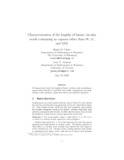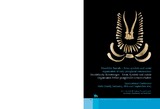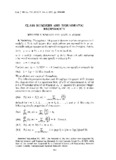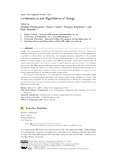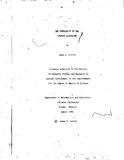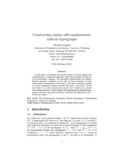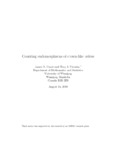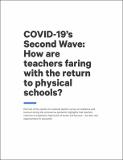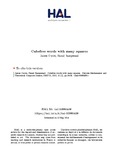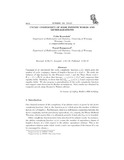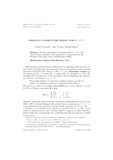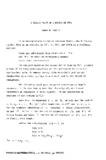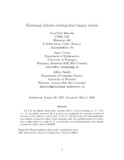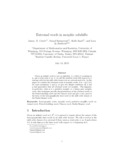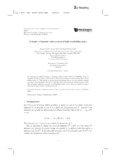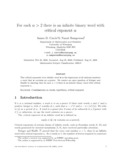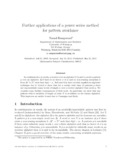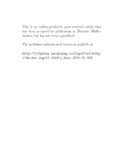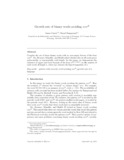Parcourir Department of Mathematics and Statistics par titre
Voici les éléments 16-35 de 73
-
Characterization of the lengths of binary circular words containing no squares other than 00, 11, and 0101
(2020-05-19)We characterize exactly the lengths of binary circular words containing no squares other than 00, 11, and 0101. -
A chrono-geographic look at Mesolithic burials: an initial study
(Landesamt für Denkmalpflege und Archäologie Sachsen-Anhalt, 2016)Over the past decade we have focused on two interrelated topics within Mesolithic burial studies, the relationship between burial number and burial date, and the chronology of Mesolithic sites with burials. Related to this ... -
Class Numbers and Biquadratic Reciprocity
(Cambridge University Press, 1982) -
Combinatorics and Algorithmics of Strings
(Dagstuhl Publishing, 2014-03-09)Strings (aka sequences or words) form the most basic and natural data structure. They occur whenever information is electronically transmitted (as bit streams), when natural language text is spoken or written down (as words ... -
The Complexity of the Simplex Algorithm
(Carleton UniversityCarleton University, 1984-08)The thesis begins by giving background in linear programming and Simplex methods. Topics covered include the duality theorem, Lemke's algorithm, and the pathological programs of Klee-Minty. Because of the bad behaviour ... -
Constructing Regular Self-complementary Uniform Hypergraphs
(Journal of Combinatorial Designs, 2011-02-17)In this paper, we examine the possible orders of t-subset-regular self-complementary k-uniform hypergraphs, which form examples of large sets of two isomorphic t-designs. We reformulate Khosrovshahi and Tayfeh-Rezaie's ... -
Counting endomorphisms of crown-like orders
(Springer, 2002-12)The authors introduce the notion of crown-like orders and introduce powerful tools for counting the endomorphisms of orders of this type. -
COVID-19’s Second Wave: How are teachers faring with the return to physical schools?
(Canadian Education Network, 2020-11-20) -
Cubefree words with many squares
(Discrete Mathematics and Theoretical Computer Science, 2014-05-13)We construct infinite cubefree binary words containing exponentially many distinct squares of length n . We also show that for every positive integer n , there is a cubefree binary square of length 2n. -
Cyclic Complexity of Some Infinite Words and Generalizations
(Integers, 2018-03)Cassaigne et al. introduced the cyclic complexity function c_x(n), which gives the number of cyclic conjugacy classes of length-n factors of a word x. We study the behavior of this function for the Fibonacci word f and the ... -
Cyclically t-complementary uniform hypergraphs
(European Journal of Combinatorics, 2010-05)A cyclically t-complementary k-hypergraph is a k-uniform hypergraph with vertex set V and edge set E for which there exists a permutation 2 Sym.V/ such that the sets E; E ; E 2; : : : ; E t1 partition the set of all ... -
Dejean's conjecture holds for n ≥ 27
(EDP Sciences, 2009)We show that Dejean’s conjecture holds for n ≥ 27. This brings the final resolution of the conjecture by the approach of Moulin Ollagnier within range of the computationally feasible. -
A direct proof of a result of Thue
(Utilitas Mathematica, 1984) -
Extremal Infinite Overlap-Free Binary Words
(The Electronic Journal of Combinatorics, 1998-05-03)Let t be the infinite fixed point, starting with 1, of the morphism μ:0→01, 1→10. An infinite word over {0,1} is said to be overlap-free if it contains no factor of the form axaxa, where a∈{0,1} and x∈{0,1}∗. We prove that ... -
Extremal words in morphic subshifts
(Elsevier, 2014-01-22)Given an infinite word x over an alphabet A, a letter b occurring in x, and a total order \sigma on A, we call the smallest word with respect to \sigma starting with b in the shift orbit closure of x an extremal word of ... -
A family of formulas with reversal of high avoidability index
(World Scientific, 2017)We present an infinite family of formulas with reversal whose avoidability index is bounded between 4 and 5, and we show that several members of the family have avoidability index 5. This family is particularly interesting ... -
For each a > 2 there is an Infinite Binary Word with Critical Exponent a
(The Electronic Journal of Combinatorics, 2008-08-31)The critical exponent of an infinite word w is the supremum of all rational numbers α such that w contains an α-power. We resolve an open question of Krieger and Shallit by showing that for each α>2 there is an infinite ... -
Further applications of a power series method for pattern avoidance
(The Electronic Journal of Combinatorics, 2011-06-21)In combinatorics on words, a word w over an alphabet ∑ is said to avoid a pattern p over an alphabet ∆ if there is no factor x of w and no non-erasing morphism h from ∆* to ∑* such that h(p) = x. Bell and Goh have recently ... -
Generating self-complementary uniform hypergraphs
(Discrete Mathematics, 2010-02)In 2007, Szymanski and Wojda proved that for positive integers n; k with k less than n, a self-complementary k-uniform hypergraph of order n exists if and only if n/k is even. In this paper, we characterize the cycle type ... -
Growth rate of binary words avoiding xxxR
(Elsevier, 2016-01)Abstract Consider the set of those binary words with no non-empty factors of the form xxx^R. Du, Mousavi, Schaeffer, and Shallit asked whether this set of words grows polynomially or exponentially with length. In this ...

